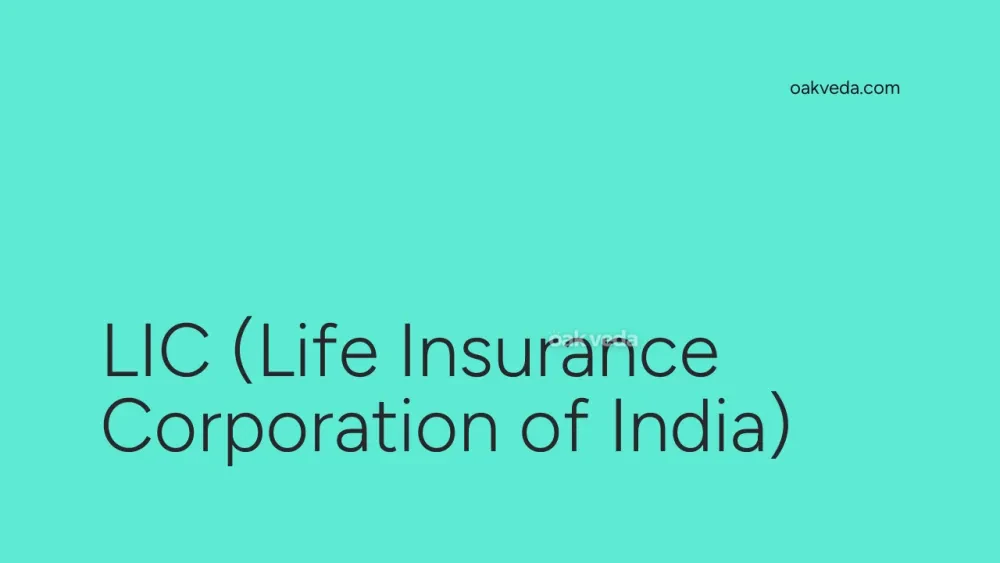
What is the Full Form of LIC?
The full form of LIC is Life Insurance Corporation of India. Established in 1956, LIC is a state-owned insurance and investment corporation in India. It plays a crucial role in providing life insurance coverage and promoting financial security among Indian citizens.
What is Life Insurance Corporation of India?
Life Insurance Corporation of India, commonly known as LIC, is the largest insurance company in India. It was created through the Life Insurance Corporation Act of 1956, which nationalized the Indian insurance industry. LIC's primary objective is to provide affordable life insurance to all segments of society, particularly focusing on rural and economically disadvantaged areas.
Origin and Development of Life Insurance Corporation of India
The history of life insurance in India dates back to the pre-independence era:
-
Pre-independence: The Oriental Life Insurance Company, established in 1818, was the first life insurance company in India. It primarily catered to European clients and charged higher premiums from Indian customers.
-
Early Indian initiatives: Surendranath Tagore founded the Hindustan Insurance Society, marking the beginning of Indian-owned insurance companies.
-
Nationalization: In 1956, the Indian government nationalized the life insurance sector due to widespread fraud and mismanagement. The Life Insurance Corporation Act of 1956 led to the formation of LIC, consolidating 245 private insurance companies under one state-owned entity.
-
Post-nationalization growth: LIC has since grown to become one of the largest financial institutions in India, serving millions of policyholders and contributing significantly to the country's economic development.
How does Life Insurance Corporation of India work?
LIC operates on the principle of risk pooling and long-term fund management. Here's a simplified explanation of its functioning:
-
Policy issuance: LIC offers various life insurance products to individuals and groups.
-
Premium collection: Policyholders pay regular premiums, which form a pool of funds.
-
Fund management: LIC invests these funds in various sectors, including government securities, infrastructure, and corporate bonds.
-
Claim settlement: In the event of a policyholder's death or policy maturity, LIC settles claims from the accumulated funds.
-
Surplus distribution: Any surplus generated is partly distributed to policyholders as bonuses and partly retained for future obligations and business expansion.
Functions of Life Insurance Corporation of India
LIC serves multiple functions in the Indian financial landscape:
-
Life insurance provision: Offering a wide range of life insurance products to cater to diverse needs.
-
Savings mobilization: Encouraging long-term savings through insurance-linked investment plans.
-
Fund deployment: Investing policyholder funds in various sectors to support national development.
-
Social security: Providing affordable insurance coverage to underprivileged sections of society.
-
Financial inclusion: Extending insurance services to rural and semi-urban areas.
Applications of Life Insurance Corporation of India
LIC's services find applications in various aspects of financial planning:
-
Risk mitigation: Providing financial protection to families in case of the policyholder's untimely death.
-
Retirement planning: Offering pension plans for post-retirement income security.
-
Child education: Providing plans specifically designed to fund children's education.
-
Wealth creation: Offering unit-linked insurance plans (ULIPs) for long-term wealth accumulation.
-
Tax planning: Many LIC policies offer tax benefits under the Indian Income Tax Act.
Features of Life Insurance Corporation of India
Key features that distinguish LIC include:
-
Government backing: As a state-owned entity, LIC enjoys implicit government guarantee.
-
Extensive network: LIC has a vast network of offices and agents across India, ensuring wide reach.
-
Product diversity: Offers a wide range of insurance and investment products to suit various needs.
-
Bonus declaration: Regular bonus declarations for participating policies enhance returns for policyholders.
-
Social welfare focus: Implements various schemes aimed at social security and financial inclusion.
Benefits of Life Insurance Corporation of India
LIC offers several advantages to policyholders and the nation:
-
Financial security: Provides a safety net for families in case of unforeseen circumstances.
-
Affordable premiums: Offers insurance coverage at competitive rates due to its large scale of operations.
-
High claim settlement ratio: Known for its high percentage of claim settlements, instilling trust among policyholders.
-
Contribution to national development: Invests in infrastructure and government securities, supporting economic growth.
-
Rural penetration: Extends insurance services to remote areas, promoting financial inclusion.
Limitations or Challenges of Life Insurance Corporation of India
Despite its strengths, LIC faces certain challenges:
-
Digital transformation: Adapting to rapidly changing technology and customer preferences in the digital age.
-
Competition from private sector: Facing increased competition since the liberalization of the insurance sector in 2000.
-
Product innovation: Need for continuous innovation to meet evolving customer needs and market trends.
-
Operational efficiency: Improving efficiency in a large, legacy organization structure.
-
Regulatory changes: Adapting to evolving regulatory norms in the insurance sector.
Future Developments in Life Insurance Corporation of India
LIC is poised for significant developments in the coming years:
-
Digital initiatives: Enhancing digital capabilities for improved customer experience and operational efficiency.
-
Product diversification: Introducing innovative products to cater to changing customer needs.
-
International expansion: Exploring opportunities to expand its presence in international markets.
-
Partial privatization: The government's plan to divest a portion of its stake in LIC through an Initial Public Offering (IPO).
-
Sustainable investing: Increasing focus on ESG (Environmental, Social, and Governance) factors in investment decisions.
FAQs on LIC Full Form
-
What is the full form of LIC? The full form of LIC is Life Insurance Corporation of India.
-
When was LIC established? LIC was established on September 1, 1956, through the Life Insurance Corporation Act.
-
Is LIC a government organization? Yes, LIC is a state-owned insurance and investment corporation of India.
-
What types of insurance does LIC offer? LIC offers various life insurance products, including term insurance, endowment plans, pension plans, and unit-linked insurance plans.
-
Can NRIs invest in LIC policies? Yes, Non-Resident Indians (NRIs) can invest in certain LIC policies, subject to specific terms and conditions.
You may be interested in:

